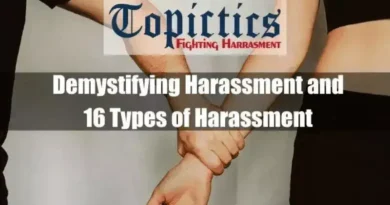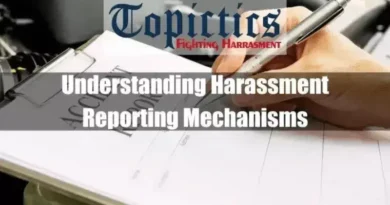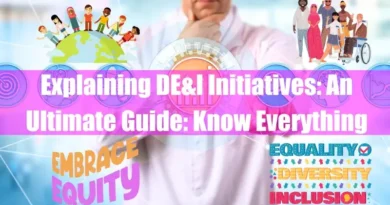Key Takeaways from “Understanding Microinvalidations”:
- Definition of Microinvalidations: Microinvalidations are subtle, often unconscious, messages that communicate discriminatory or invalidating messages to individuals or groups based on their race, ethnicity, gender, sexual orientation, religion, or other social group affiliations. They differ from microaggressions in that they are generally unconscious and focus on invalidating an individual’s experiences or identity.
- Context of Microinvalidations: Understanding implicit biases and intersectionality is crucial in grasping the impact of microinvalidations. Implicit biases influence interactions, while intersectionality acknowledges that individuals hold multiple social identities, amplifying experiences of discrimination.
- Types of Microinvalidations: They can be verbal, non-verbal, or environmental. Verbal microinvalidations include making assumptions, offering unsolicited advice, using jokes based on stereotypes, or silencing. Non-verbal microinvalidations involve body language, facial expressions, and environmental cues that convey bias or invalidation.
- Impact of Microinvalidations: They can have significant psychological effects such as stress, anxiety, depression, and feelings of invalidation. Socially, they perpetuate stereotypes, create hostile environments, and impede progress toward inclusivity and equity.
- Addressing Microinvalidations: Strategies include recognizing them, responding appropriately (directly or indirectly), and bystander intervention. Individual action involves examining biases, practicing empathy, challenging microinvalidations, educating oneself and others, and supporting diverse voices. Institutional action includes diversity training, open communication, policy implementation, diverse team building, and fostering a culture of respect and belonging.
- Creating Inclusive Environments: Ongoing learning, dialogue, and celebration of diversity are essential. Maintaining a growth mindset, engaging in open dialogue, and embracing diversity can lead to a more inclusive and equitable world where microinvalidations become relics of the past.
I. Introduction
Struggle for inclusivity and understanding is paramount in today’s world. One crucial aspect of achieving this goal lies in recognizing and addressing microinvalidations. These seemingly innocuous comments, behaviors, and environmental cues, often unintentional, can significantly impact individuals and communities belonging to marginalized groups.
II. Defining Microinvalidations
The term “microinvalidation” was first coined by Dr. Derald Wing Sue in the late 1980s. He defined it as “verbal or nonverbal messages that communicate subtle, often unconscious, discriminatory or invalidating messages to a person or group.” These messages, while seemingly minor, can undermine, negate, or dismiss the lived experiences, feelings, and identities of individuals based on their race, ethnicity, gender, sexual orientation, religion, or other social group affiliations.
It’s crucial to differentiate microinvalidations from microaggressions. While both contribute to a negative and hostile climate for marginalized groups, they differ in intent and severity. Microaggressions, while often unintentional, can stem from conscious biases and can be more explicit or intentional in nature. Microinvalidations, however, are generally unconscious and focus specifically on invalidating an individual’s experiences or identity.
III. Understanding the Context of Microinvalidations
To fully grasp the impact of microinvalidations, it’s essential to consider the broader context in which they occur. Two key factors contribute significantly:
A. Implicit Biases:
Regardless of background or intention, everyone holds implicit biases, also known as unconscious biases. These are ingrained associations and stereotypes formed unknowingly about different social groups. These biases can influence our thoughts, behaviors, and interactions with others, sometimes leading to microinvalidations.
B. Intersectionality:
It’s also crucial to understand intersectionality, a concept developed by Kimberlé Crenshaw, which acknowledges that individuals hold multiple social identities (race, gender, class, etc.). The experiences of discrimination they face are interconnected and amplified by the intersection of these identities. For example, a Black woman may experience more frequent and harmful microinvalidations compared to a white man due to the intersection of her race and gender.
By understanding the interplay between implicit biases, intersectionality, and the context in which microinvalidations occur, we can better appreciate their subtle yet cumulative effects and their potential to harm individuals and communities.
Also, read:
IV. Types of Microinvalidations

Microinvalidations can manifest in various ways, making them difficult to identify and address. However, understanding the different types and their impact is crucial for creating a more inclusive environment. Here, we’ll explore three major categories:
A. Verbal Microinvalidations
These are spoken or written messages that, while seemingly harmless or even complimentary, can invalidate or dismiss an individual’s experiences or identity. Common examples include:
- Making assumptions: “You’re so articulate for a [insert group affiliation].” While attempting to be a compliment, this statement reinforces harmful stereotypes. It suggests that the individual’s intelligence is unexpected based on their social group.
- Unsolicited advice: “You should relax; you’re probably overreacting.” This comment invalidates the individual’s emotions and dismisses their perspective.
- Jokes and humor: Jokes based on stereotypes or that mock someone’s identity, even if not intended as malicious, can be hurtful and invalidating.
- Silencing: Interrupting, talking over, or dismissing someone’s opinions can create a feeling of being unheard and invalidated.
These seemingly minor comments can significantly negatively affect individuals and communities. They can lead to:
- Feelings of invalidation, frustration, and anger.
- Reduced sense of belonging and self-worth.
- Increased stress, anxiety, and depression.
- Reinforcement of negative stereotypes and discrimination.
Related articles:
B. Non-Verbal Microinvalidations
These are non-spoken messages conveyed through body language, facial expressions, and actions that can communicate subtle forms of bias and invalidation. Examples include:
- Body language: Avoiding eye contact, crossing arms, or turning away while someone is speaking can convey disinterest or disrespect.
- Microaggressions: While often categorized separately, microaggressions can sometimes manifest non-verbally, such as clutching your purse tightly when walking past someone from a different race.
- Environmental cues: The lack of representation in leadership positions, imagery, or cultural references within an environment can signal to individuals from marginalized groups that they are not valued or welcome.
Also, read:
C. Environmental Microinvalidations
These microinvalidations are embedded within the physical and social environment and communicate messages of exclusion or dismissal. Examples include:
- Lack of representation: The absence of individuals from diverse backgrounds in leadership positions, educational materials, or media can convey that they are not valued or important.
- Inaccessible spaces: Physical spaces lacking ramps, elevators, or gender-neutral facilities can exclude individuals with disabilities or non-binary individuals.
- Culturally insensitive practices: Policies or practices that do not consider cultural norms or traditions can alienate individuals from different cultural backgrounds.
Environmental microinvalidations can be particularly insidious as they are often systemic and not readily apparent. However, recognizing and addressing them is crucial for fostering inclusivity. This might involve:
- Actively seeking diverse representation in leadership positions, educational materials, and media.
- Ensuring accessibility in physical and virtual spaces.
- Being mindful of cultural sensitivities when designing policies and practices.
Also, read:
- Demystifying Harassment and 16 Types of Harassment
- Cultural Norms and Harassment: Understanding the Link
- Understanding Harassment Reporting Mechanisms
V. The Impact of Microinvalidations

While seemingly harmless on the surface, microinvalidations, when experienced repeatedly, can significantly and detrimentally impact individuals and communities. Here, we’ll delve deeper into the diverse ways these subtle messages can affect us:
A. Psychological Effects
- Stress, anxiety, and depression: The constant barrage of microinvalidations can create a chronic stress response, leading to feelings of anxiety, depression, and exhaustion.
- Feeling invalidated and unseen: Microinvalidations can lead to a sense of being unheard, unseen, and ultimately, invalidated as an individual and your lived experiences.
- Internalized messages and self-doubt: Repetitive exposure to messages that undermine your identity and experiences can lead to internalizing these messages and developing self-doubt and low self-esteem.
B. Social and Cultural Effects
- Perpetuating stereotypes and discrimination: Microinvalidations, even if unintentional, reinforce negative stereotypes and contribute to a larger climate of discrimination and prejudice towards marginalized groups.
- Creating a hostile and unwelcoming environment: When individuals are constantly bombarded with microinvalidations, it creates a hostile and unwelcoming environment that hinders their sense of belonging and participation.
- Impeding progress towards inclusivity and equity: Microinvalidations act as roadblocks to achieving true inclusivity and equity within society, hindering progress towards a more just and equitable world.
Also, read:
- How to Create an Anti-Retaliation Policy
- Fear of Reprisal in the Workplace
- Documenting Evidence in Harassment Cases: Best Practices
VI. Addressing Microinvalidations

Microinvalidations, while pervasive, are not inevitable. By equipping ourselves with the knowledge and tools to recognize and address them, we can create a more inclusive and respectful environment for everyone. Here, we’ll explore strategies for addressing microinvalidations, both individually and collectively:
A. Recognizing Microinvalidations
The first step towards addressing microinvalidations is developing the ability to recognize them. This requires:
- Understanding different microinvalidations: Familiarize yourself with the various forms microinvalidations can take, as discussed in Part II.
- Examining implicit biases: Acknowledge your potential biases and how they might influence your interactions with others.
- Being mindful of the context: Consider the context in which interactions occur to understand the potential impact of seemingly harmless comments or behaviors.
B. Responding to Microinvalidations
Responding to microinvalidations can be challenging, especially when caught off guard. However, there are various ways to address them, depending on the situation and your comfort level:
- Direct response: If you feel safe and empowered, you can directly address the microinvalidation by calmly and assertively pointing out the underlying message and its impact on you.
- Indirect response: If a direct response feels overwhelming, you can employ indirect methods like expressing your discomfort, changing the subject, or simply removing yourself from the situation.
- Seeking support: Talking to a trusted friend, family member, therapist, or colleague can provide emotional support and guidance in navigating such situations.
C. Bystander Intervention
Witnessing someone else experience microinvalidation can be difficult. However, intervening as a bystander can provide crucial support and send a strong message against such behavior:
- Assessing the situation: Ensure your safety and the safety of the individual experiencing the microinvalidation before intervening.
- Offering support: Privately acknowledge the individual’s experience and offer support if desired.
- Addressing the behavior: If appropriate, you can directly address the microinvalidation with the person who engaged in it, expressing your disapproval and stating the impact of their behavior.
Remember, the most important thing is to choose a response that feels safe and comfortable for you. Every situation is unique, and there is no one-size-fits-all approach.
Also, read:
- 20 Quid Pro Quo Harassment Examples and How to Stop Them
- Quid Pro Quo Harassment vs. Hostile Work Environment Harassment
- Is Quid Pro Quo Illegal? 21 Accused Celebrities Examples
VII. Creating a More Inclusive Environment

While individual responses to microinvalidations are crucial, creating a truly inclusive environment requires broader, systemic change. This involves both individual and institutional action:
A. Individual Action
Building a more inclusive world starts with us, individually. Here are some ways we can contribute:
- Examining personal biases and assumptions: Actively reflect on your own unconscious biases and challenge harmful assumptions you might hold.
- Practicing active listening and empathy: Genuinely listen to others’ experiences and perspectives with empathy, trying to see the world from their point of view.
- Challenging microinvalidations when safe to do so: When you witness or experience a microinvalidation, consider intervening safely and respectfully, depending on the situation and your comfort level.
- Educating yourself and others: Continuously educate yourself about different forms of microinvalidations, their impact, and strategies for addressing them. Share this knowledge with others and encourage open conversations.
- Supporting diverse voices and initiatives: Actively seek out and support voices from diverse backgrounds, amplifying their perspectives and experiences. Additionally, support initiatives and organizations working towards equity and inclusion.
B. Institutional Action
Organizations, institutions, and companies also have a significant role to play in fostering inclusivity. Here are some key steps they can take:
- Implementing diversity and inclusion training: Providing ongoing training on implicit bias, microinvalidations, and inclusive communication for all staff and leadership.
- Fostering open communication and feedback mechanisms: Create safe spaces for employees to voice concerns and experiences of microinvalidations, ensuring they are heard and addressed constructively.
- Developing and enforcing policies against discrimination and harassment: Establish clear policies and procedures addressing discriminatory behavior and harassment, including microaggressions and microinvalidations.
- Building diverse and inclusive teams: Actively seek and incorporate diverse perspectives and experiences in leadership positions and throughout the organization.
- Creating an environment of respect and belonging: Promote an organizational culture that values respect, appreciation, and belonging for all individuals, regardless of their background or identity.
By taking these steps, individuals and institutions can work together to create a more inclusive and equitable environment free from the harmful effects of microinvalidations.
Also, read:
- Explaining Quid Pro Quo Harassment Under Title IX
- Quid Pro Quo Harassment: What It Is? Know Everything
- How to Prevent Quid Pro Quo Harassment: 20 Effective Ways
VIII. Conclusion: The Power of Ongoing Learning and Dialogue
Microinvalidations, while seemingly minor, can have a profound negative impact on individuals and communities. Recognizing their subtle yet impactful nature is crucial for creating a more inclusive and equitable world.
Throughout this comprehensive exploration, we’ve delved into the different types of microinvalidations, their social and psychological effects, and strategies for addressing them individually and collectively. We’ve also emphasized the importance of institutional action in fostering inclusive environments.
However, it’s crucial to remember that the journey towards inclusivity is ongoing. As societal norms and experiences evolve, our understanding of microinvalidations must continuously adapt. This requires:
- Maintaining a growth mindset: Approaching the topic with a willingness to learn and grow, acknowledging that our understanding of microinvalidations may not always be complete.
- Engaging in open dialogue: We should foster open and honest conversations about microinvalidations with individuals from diverse backgrounds and within our communities. This dialogue can help us deepen our understanding, challenge assumptions, and identify solutions.
- Celebrating diversity and inclusion: Recognizing and celebrating diversity’s richness and value to our individual and collective experience.
By embracing ongoing learning, fostering dialogue, and celebrating diversity, we can work towards a future where microinvalidations become relics of the past and inclusivity becomes the norm, not the exception. This journey requires continuous effort and commitment from all. Still, the potential for a more just and equitable world makes it worthwhile.
Also, read:
- Explaining Verbal Harassment or Abuse in Various Settings
- Explaining Non-verbal Harassment or Abuse
- Explaining Physical, Visual, and Online Harassment
IX. FAQs
A. What are additional strategies for responding to microinvalidations if a direct response feels overwhelming?
Beyond direct and indirect responses, individuals can navigate uncomfortable microinvalidation situations through various strategies. Using humor can lighten the mood and deflect the negativity while shifting the focus and steering the conversation away from harmful comments. Additionally, if comfortable, one can gently explain how the message felt invalidating, helping the other person understand the impact of their words or actions.
B. What are examples of microinvalidations based on different social identities (e.g., age, religion, disability)?
While the focus on race, ethnicity, and gender is crucial, including examples of microinvalidations based on age, religion, disability, and sexual orientation paints a more complete picture. Imagine being told you “look good for your age” or facing assumptions about your tech skills solely based on your age. Similarly, religious microinvalidations can involve making uninformed assumptions about beliefs or dietary restrictions. By considering these broader aspects, we gain a deeper understanding of the diverse ways microinvalidations can manifest.
C. How can individuals who experience microinvalidations practice self-care and cope with the emotional impact?
Beyond recognizing the impact of microinvalidations, it’s crucial for individuals who experience them to prioritize their mental health through relaxation techniques or professional help, build a supportive network of friends, family, or therapists, and establish boundaries by saying no to draining requests and prioritizing activities that bring them joy and empowerment.
D. How can microinvalidations be different in online spaces compared to face-to-face interactions?
While the core focus has been on microinvalidations in face-to-face interactions, understanding how these subtle biases manifest online is vital for navigating digital spaces effectively. Offensive language, exclusion from online communities, and the use of stereotypes in online discussions are all examples of microinvalidations that can occur online. Recognizing and addressing these instances is crucial for fostering a safe and inclusive online environment.
E. How can educators and parents play a role in preventing and addressing microinvalidations in educational settings?
While primarily addressing professional and social settings, this exploration could be extended to educational environments, highlighting students’ and educators’ unique challenges. By integrating lessons on microaggressions and inclusivity into the curriculum, educators can empower students. Similarly, parents can play a crucial role by having open conversations with their children about recognizing and addressing microinvalidations and fostering a more inclusive learning environment at home and beyond.
F. What are some potential limitations or challenges in addressing microinvalidations effectively?
Addressing microinvalidations can be complex, as several factors create challenges. People who speak up might fear retaliation, especially at work. Even those committed to inclusivity may hold unconscious biases, making it difficult to recognize and address their microinvalidations. Additionally, a lack of awareness about the concept and its impact can hinder effective efforts to address them.









